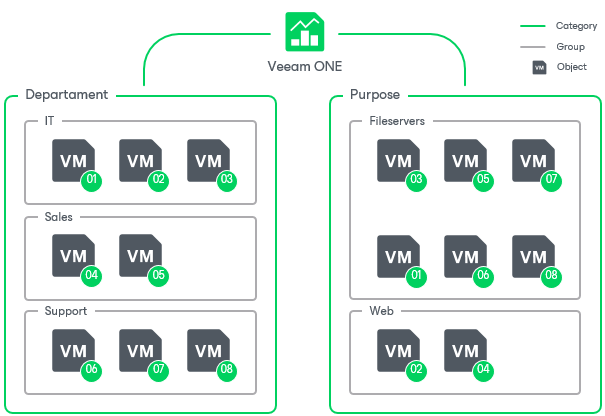Categorization Model and Methods
To present the virtual or physical infrastructure, Veeam ONE Client uses the model that includes categories, groups and objects:
- Category is a logical division or a sector of the virtual or physical infrastructure. Each category includes one or more groups.
Categories can be static or dynamic:
- Static categories include a user-defined number of groups. You can manually create groups that Veeam ONE Client will populate each time data collection runs.
- Dynamic categories can include one or more groups that Veeam ONE Client creates and populates automatically each time data collection runs.
Note |
Veeam ONE Client Client comes with the predefined category named B&R Job. The category includes groups of VMs protected by Veeam backup jobs, Veeam replication jobs and Veeam CDP policies that are managed by Veeam Backup & Replication servers connected to Orchestrator. Note that vCenter Servers where these VMs belong must also be connected to Orchestrator to allow Veeam ONE Client to categorize the VMs. Do not rename or edit the B&R Job category — this may cause errors when trying to use inventory groups from the category in recovery plans. You can delete this category if you no longer need it. To learn how to delete categories, see Deleting Categories. |
- Group is a collection of virtual or physical infrastructure objects that share same characteristics or match same criteria. You can think of a group as a tag assigned to an object.
Each group includes one or more objects.
- Objects are categorized elements of the virtual or physical infrastructure.
There are five types of objects you can categorize in Veeam ONE Client: clusters, hosts, storage objects, virtual machines and Veeam agents.
The following picture illustrates an example of the Veeam ONE Client categorization model for virtual machines.

In the example above, the categorization model includes categories Department and Purpose.
- Department category includes groups IT, Sales and Support
- Purpose category includes groups Fileservers and Web
Virtual machines numbered 1-8 are included in groups within both categories.
Categorization Methods
To categorize infrastructure objects into groups, you can use the following methods:
- Default categorization — the method used by Veeam ONE Client that allows you to import an existing categorization model from the management servers. Default categorization is the only way to group datastore clusters.
- Import-based categorization — the method that allows you to import a categorization model using a .CSV file. You can either synchronize Business View categorization data with categorization data from 3rd party software automatically, or categorize virtual or physical infrastructure objects outside Veeam ONE Client and import this categorization data manually.
- Single-parameter categorization — the method that allows you to configure dynamic categories. Veeam ONE Client will create groups automatically based on the values of a single property of an object.
- Multiple-condition categorization — the method that allows you to configure static categories and create groups manually by combining multiple object properties and logical operators.
- Categorization with grouping expressions — the method that allows you to configure dynamic categories. Veeam ONE Client will create groups automatically based on object properties, operators and methods included into expressions.
You can also manually assign the existing categorization values to your infrastructure objects as described in section Assigning Categorization Values Manually.
Note |
Veeam ONE Client does not allow you to enable synchronization with both vCenter Server tags and a .CSV file at the same time — when you switch between these options or select the Do not import option, Veeam ONE Client deletes all previously imported categories. However, you can combine either of these categorization models with custom categories and groups created using the single-parameter, multiple-condition and grouping expression categorization. |